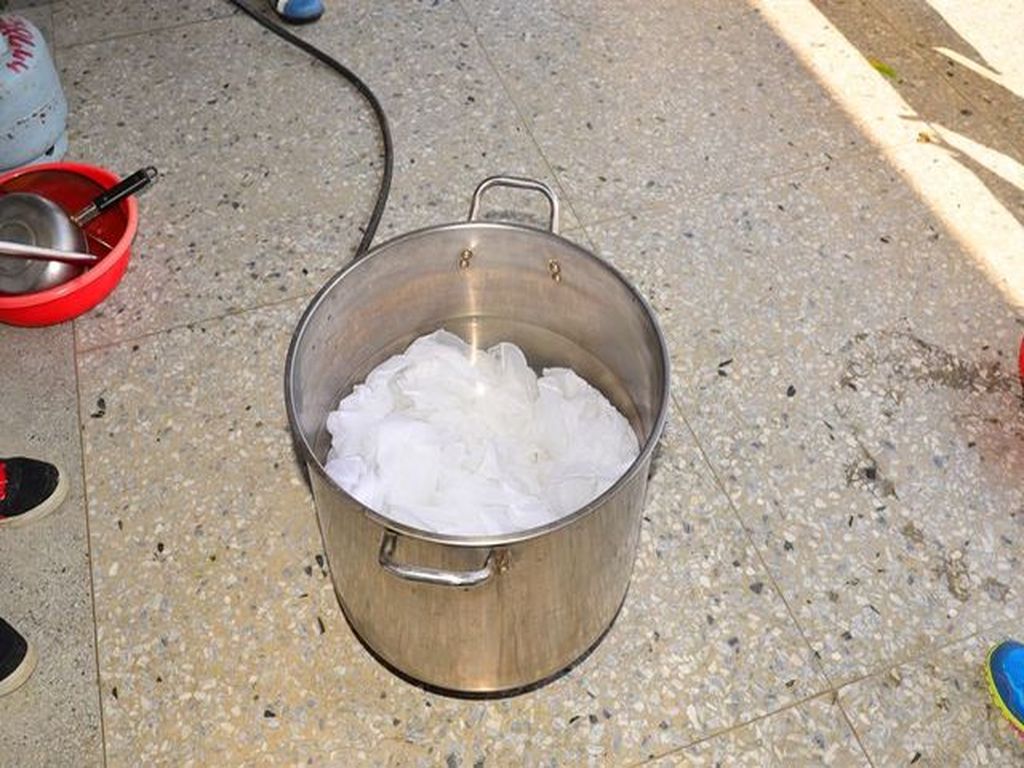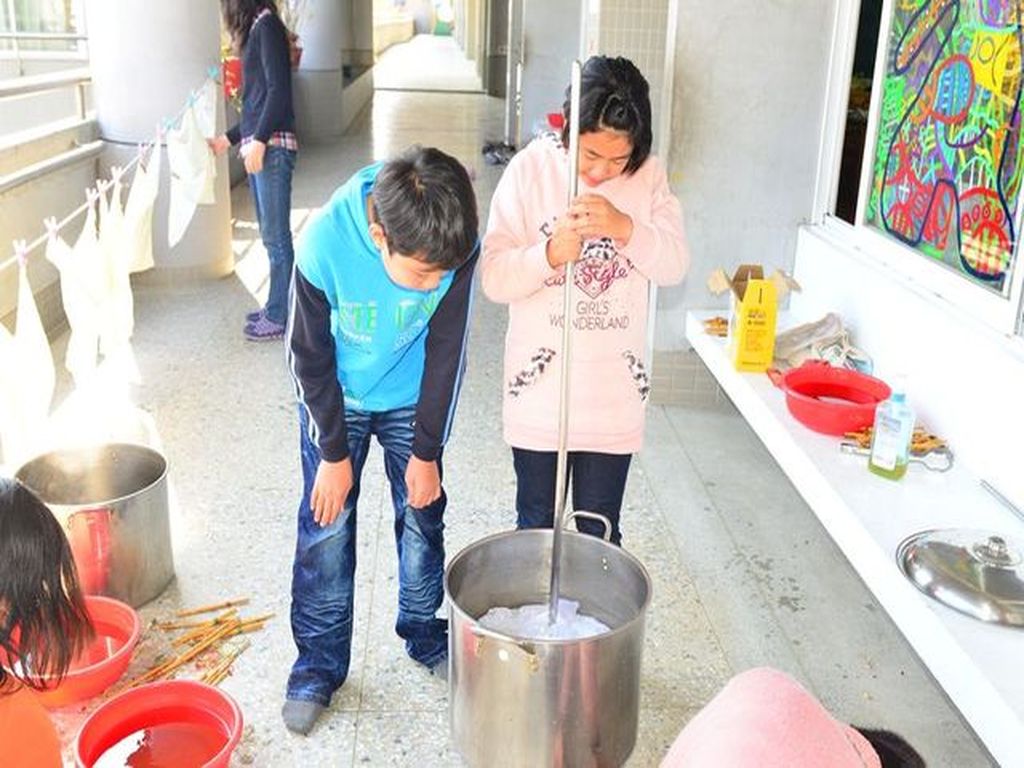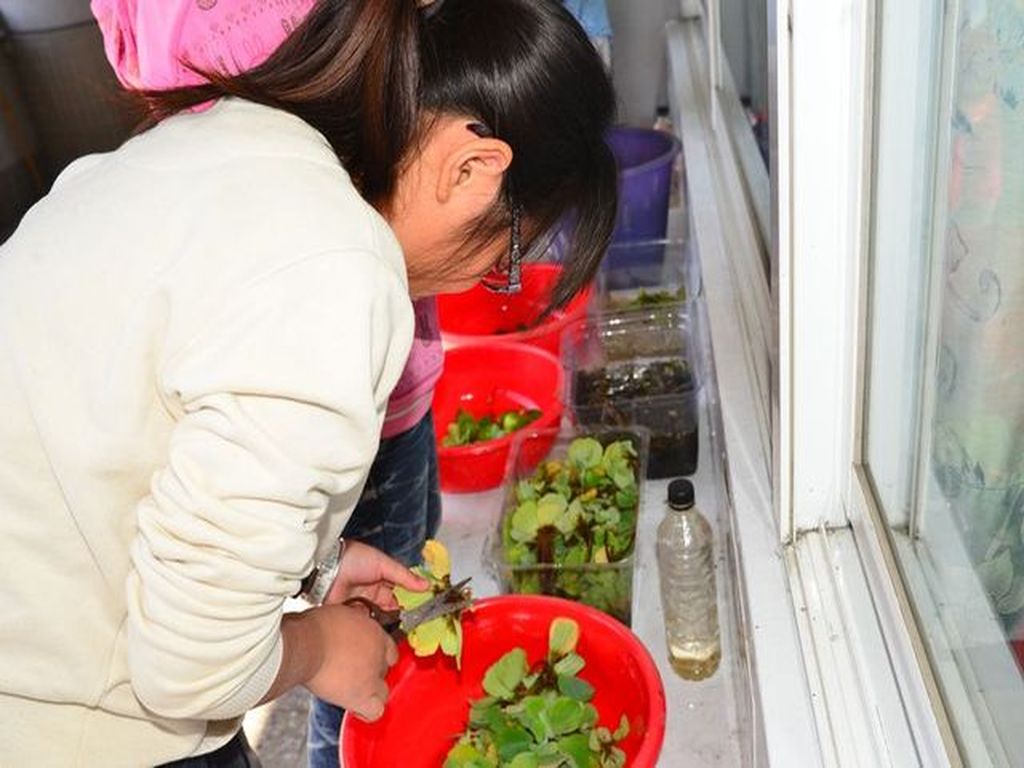Vegetable dyes process

Step one: prepare cloth
Cloth refining definitions: Use refining agent (available neutral soap) cleaning cotton / linen and other fabrics, cloth to remove impurities on.
Cloth scouring process:
1. water 40 times the amount of cloth placed heavy stainless steel pot (fabric weight in kilograms, measured in liters of water, such as: fabric weight 1 kg, 40 liters of water is necessary fabric weight: water = 1:40, this known as "bath ratio" or "liquid ratio").
2.placed in the water scouring agent, detergent or dish detergent, soap, silk, and stir until dissolved.
3.soaked cloth into the water (wet), wring flattened after release into the pot.

4.in the pot soak for 5 minutes after the opening heat and simmer for 5 minutes, sub-high heat to boil water during the cloth must stir every few minutes. Water roll and cook over low heat for 30 minutes, it is best to continue stirring period, at least every five minutes stir, can not be lazy.
5.After 30 minutes turn off the water to boil in a pot spoon to scoop out from 5 tablespoons of hot water, then pour 5 tablespoons cold wok, stir; and from the pot and then scoop out the 5 tablespoons of hot water, then pour 5 tablespoons cold wok, stir. So repeatedly, until the pot temperature water drops, you can come up with the cloth, wash with water to clean, then dehydrated and dried for use. Remember scoured cloth Do not use iron ironing.
Cloth scouring the refining agent used:
1.large scouring -. Sodium hydroxide (fabric weight of 1% to 3%) --- dirty cloth (sizing) and thick fabrics
2.small scouring -. Soda or baking soda (fabric weight of 1% to 5%) --- relatively clean cloth
3.soap cook - better --- with soap silk cloth has been refined over a period of time before you want to dye
Surfactant: 0.5 ~ 1 g / l, such as: salad off (dish soap), washing powder, soap, silk
Step two: the extraction and production of dye mordant

Stained wood processing
1.Stained timber clean (flower stamen and pollen to go), cut into small pieces, put into stainless steel pot.
2.The pot into the fabric weight 40 times the amount of water, bring to a boil with the fire after a small fire and cook for 30 minutes.
3.The dye was filtered off and set aside.
※dry wood can be boiled several times, leaves can cook 2 to 3 times, once on grass do not cook it. So the number 40 times the amount of water can be assessed as the cook. For example: To boil 40 liters of dye in three installments, the first boil 25 liters, 10 liters a second cook, third cook for 5 liters.
※cloth and dyed material ratio: grass => 1:6 to 8 leaves => 1:3 to 4 dry material => 1:1
Optional mordan
1.choice of mordant: aluminum acetate (fabric weight of 10% or less), the effect is better but the price is more expensive; alum (fabric weight of 8%), the price of the finished product lighter cheaper; copper acetate (fabric weight of 10 % or less), finished color than bright; iron acetate (fabric weight of 5% or less), finished color dark.
2.take appropriate mordant: according to the type of fabric in different proportions modulation mordant, wool 8-12%; silk 20%; cotton / linen 5%.
3.preparatory mordant bath: (1) take appropriate mordant with a little hot water and stir to make a mordant completely dissolved (2) at least 25:1 (fabric weight) than the mordant bath tone synthesis and pre-dissolved. mordant bath.
4.mordant: (1) will be borne pollutants immersed in the dye bath to simmer for 20-30 minutes. (2) Remove the drain pollutants are ready staining (Ruoyu dyed darker, slightly damp can be sealed in a zipper bag pollutants few days, so mordant fully penetrate the fibers inside).
※mordant reusable again next time use, the need to re-join when the second fabric weight of 3% of the amount
※copper acetate is no longer used because it contains heavy metals, wood ash and must be filtered upper clear water, such as the precipitate was dried, wrapped in newspaper and dispose of the garbage truck.
Step Three: Dyeing
(Use stainless steel vats and utensils, water hardness must not exceed 300ppm)
1.proper amount of dye: fabric weight of 3% -15%
2.prepare the dye bath:
(1)The dye is dissolved in a little water and sufficiently stirred to completely dissolve the dye.
(2)At least 25:1 (fabric weight) pre-dissolved in the bath ratio of the dye bath of dye synthesis.
(3)The dye bath temperature (temperature to be maintained throughout): 85 ° to 90 ° C
3.dyeing process:
(1)Lashing good cloth soaked into the water (soaked) wring.
(2)Into the bath in the cloth (fabric and dye bath ratio of 1:20 to 60, typically 1:40) soak for 5 minutes (first bath is preferably cooled to below 40 ℃).
(3)Open a small fire five minutes after the fire to boil and then turn a small fire holding temperature 20 minutes (a distance of about 30 to 40 minutes), stirring from time to period.
(4)Flameout, wring out the cloth, spread into the mordant mordant in 30 minutes, during which should have been stirring. (Fabric dye bath with media ratio of 1:15 to 30)
(5)Wring out the cloth, wring out after a little cleaning, re-staining dye into again for 30 minutes.
(6)To turn off the stand until cool dye was removed about 60 ℃ wring pollutants.
(7)By way of excess dye rinse wash after dehydration in addition to semi-tie (also available in addition to all dry and then tied).
(8)Again rinsed (can add dish soap, neutral detergent), the dry, cold ironing.
Step Four: soaping
Washing: The dyed material is dissolved in hot water 60 ℃ 4% of fabric weight (environmentally friendly) neutral soap, wash 3 minutes.
※Just finished dyed cloth is best to take a long time to stabilize and then use other colors





